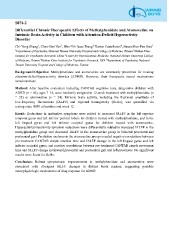Page 321 - merged
P. 321
S074-2
Differential Chronic Therapeutic Effects of Methylphenidate and Atomoxetine on
Intrinsic Brain Activity in Children with Attention-Deficit/Hyperactivity
Disorder
Chi-Yung Shang1, Chao-Gan Yan2, Wen-Yih Isaac Tseng3, Xavier Castellanos4, Susan Shur-Fen Gau5
1Department of Psychiatry, National Taiwan University Hospital and College of Medicine, Taiwan 2Nathan Kline
Institute for Psychiatric Research, China 3Center for Optoelectronic Medicine, National Taiwan University College
of Medicine, Taiwan 4Nathan Kline Institute for Psychiatric Research, USA 5Department of Psychiatry, National
Taiwan University Hospital and College of Medicine, Taiwan
Background/Objective: Methylphenidate and atomoxetine are commonly prescribed for treating
attention-deficit/hyperactivity disorder (ADHD). However, their therapeutic neural mechanisms
remain unclear.
Method: After baseline evaluation including CANTAB cognitive tests, drug-naïve children with
ADHD (n = 46), ages 7–16, were randomly assigned to 12-week treatment with methylphenidate (n
= 22) or atomoxetine (n = 24). Intrinsic brain activity, including the fractional amplitude of
low-frequency fluctuations (fALFF) and regional homogeneity (ReHo), was quantified via
resting-state fMRI at baseline and week 12.
Result: Reductions in inattentive symptoms were related to increased fALFF in the left superior
temporal gyrus and left inferior parietal lobule for children treated with methylphenidate, and in the
left lingual gyrus and left inferior occipital gyrus for children treated with atomoxetine.
Hyperactivity/impulsivity symptom reductions were differentially related to increased fALFF in the
methylphenidate group and decreased fALFF in the atomoxetine group in bilateral precentral and
postcentral gyri. Prediction analyses in the atomoxetine group revealed negative correlations between
pre-treatment CANTAB simple reaction time and fALFF change in the left lingual gyrus and left
inferior occipital gyrus, and positive correlations between pre-treatment CANTAB simple movement
time and fALFF change in bilateral precentral and postcentral gyri and left precuneus. No significant
results were found for ReHo.
Conclusion: Robust symptomatic improvements to methylphenidate and atomoxetine were
associated with divergent fALFF changes in distinct brain regions, suggesting possible
neurophysiologic mechanisms of drug response for ADHD.

